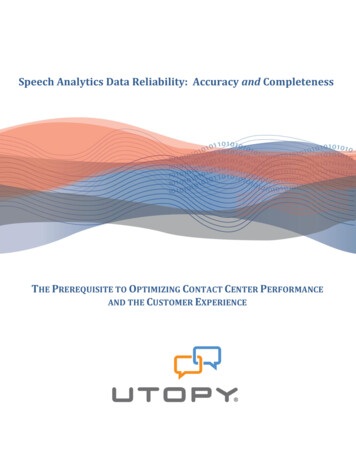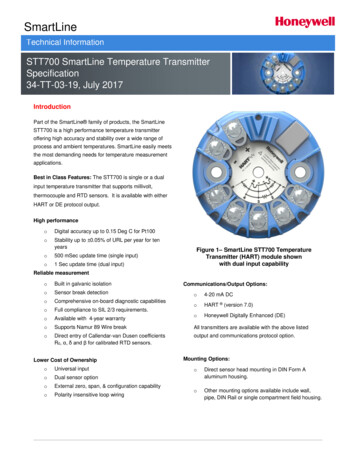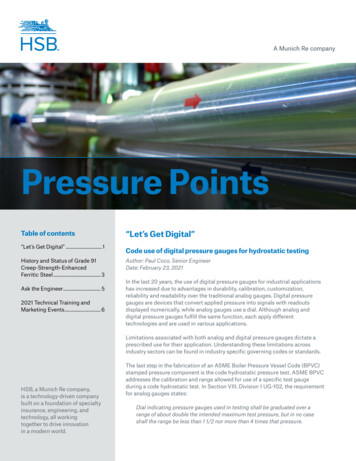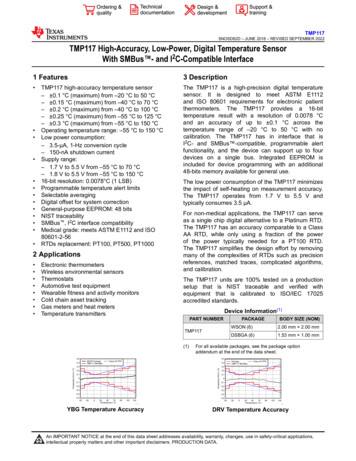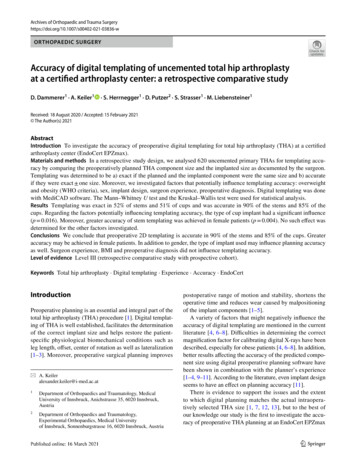
Transcription
Archives of Orthopaedic and Trauma RTHOPAEDIC SURGERYAccuracy of digital templating of uncemented total hip arthroplastyat a certified arthroplasty center: a retrospective comparative studyD. Dammerer1 · A. Keiler1· S. Herrnegger1 · D. Putzer2 · S. Strasser1 · M. Liebensteiner1Received: 18 August 2020 / Accepted: 15 February 2021 The Author(s) 2021AbstractIntroduction To investigate the accuracy of preoperative digital templating for total hip arthroplasty (THA) at a certifiedarthroplasty center (EndoCert EPZmax).Materials and methods In a retrospective study design, we analysed 620 uncemented primary THAs for templating accuracy by comparing the preoperatively planned THA component size and the implanted size as documented by the surgeon.Templating was determined to be a) exact if the planned and the implanted component were the same size and b) accurateif they were exact one size. Moreover, we investigated factors that potentially influence templating accuracy: overweightand obesity (WHO criteria), sex, implant design, surgeon experience, preoperative diagnosis. Digital templating was donewith MediCAD software. The Mann–Whitney U test and the Kruskal–Wallis test were used for statistical analysis.Results Templating was exact in 52% of stems and 51% of cups and was accurate in 90% of the stems and 85% of thecups. Regarding the factors potentially influencing templating accuracy, the type of cup implant had a significant influence(p 0.016). Moreover, greater accuracy of stem templating was achieved in female patients (p 0.004). No such effect wasdetermined for the other factors investigated.Conclusions We conclude that preoperative 2D templating is accurate in 90% of the stems and 85% of the cups. Greateraccuracy may be achieved in female patients. In addition to gender, the type of implant used may influence planning accuracyas well. Surgeon experience, BMI and preoperative diagnosis did not influence templating accuracy.Level of evidence Level III (retrospective comparative study with prospective cohort).Keywords Total hip arthroplasty · Digital templating · Experience · Accuracy · EndoCertIntroductionPreoperative planning is an essential and integral part of thetotal hip arthroplasty (THA) procedure [1]. Digital templating of THA is well established, facilitates the determinationof the correct implant size and helps restore the patientspecific physiological biomechanical conditions such asleg length, offset, center of rotation as well as lateralization[1–3]. Moreover, preoperative surgical planning improves* A. Keileralexander.keiler@i-med.ac.at1Department of Orthopaedics and Traumatology, MedicalUniversity of Innsbruck, Anichstrasse 35, 6020 Innsbruck,Austria2Department of Orthopaedics and Traumatology,Experimental Orthopaedics, Medical Universityof Innsbruck, Sonnenburgstrasse 16, 6020 Innsbruck, Austriapostoperative range of motion and stability, shortens theoperative time and reduces wear caused by malpositioningof the implant components [1–5].A variety of factors that might negatively influence theaccuracy of digital templating are mentioned in the currentliterature [4, 6–8]. Difficulties in determining the correctmagnification factor for calibrating digital X-rays have beendescribed, especially for obese patients [4, 6–8]. In addition,better results affecting the accuracy of the predicted component size using digital preoperative planning software havebeen shown in combination with the planner’s experience[1–4, 9–11]. According to the literature, even implant designseems to have an effect on planning accuracy [11].There is evidence to support the issues and the extentto which digital planning matches the actual intraoperatively selected THA size [1, 7, 12, 13], but to the best ofour knowledge our study is the first to investigate the accuracy of preoperative THA planning at an EndoCert EPZmax13Vol.:(0123456789)
Archives of Orthopaedic and Trauma Surgerycenter [14, 15]. At such a certified arthroplasty department,endoprosthetic interventions and preoperative templatingare performed according to the guidelines and specifications of EndoCert [16, 17]. EndoCert is an initiative of theGerman Society for Orthopaedics and Orthopaedic Surgery(DGOOC) and is the world’s first system for the certification of medical facilities in the field of joint replacement[14]. The EndoCert certification system is intended to ensurehigh-quality patient care and high patient safety in endoprosthetic procedures [16]. The process quality, interdisciplinaryand constantly evolving treatment paths as well as a highlevel of training for all professional groups involved in thetreatment are of central importance in the certification process [14, 17]. In addition, certified surgeons have to performa predetermined number of joint replacements per year [17].Institutions that meet the requirements can be certified as anendoprosthetic center or endoprosthetic center for maximumcare [15, 17].We, therefore, aimed to (a) determine in how many casespreoperative templating accurately matched the implant sizechosen intraoperatively and (b) analyse factors that mighthave influenced the accuracy of preoperative digital templating in patients who underwent THA in an EndoCert maxcenter (experience, body mass index (BMI), sex, implantdesign and preoperative diagnosis).Materials and methodsThe study protocol was approved by the local ethics committee of the Medical University (No. 1150/2019) andperformed in line with the principles of the Declaration ofHelsinki.We retrospectively investigated and included all patientswho underwent primary THA at our department betweenJanuary 2017 and August 2019. A total of 786 patients, giving a total of 843 implanted THAs, were investigated. Inclusion criteria were defined solely as the implantation of a primary uncemented total hip implant in the above-mentionedand defined period of time. Exclusion criteria were priorsurgical interventions in the hip joint, previous fractureswith joint involvement, cemented THA, revision surgery andintraoperative complications such as periprosthetic fracturesand malalignment of the femoral stem in postoperative anterior–posterior X-rays (defined as 5 varus or valgus). Atotal of 578 patients met our inclusion criteria, resulting in620 uncemented THAs.Socio-demographic data and patient-related factors werecollected to analyse a possible influence on the preoperative planning and the intraoperatively selected componentsize. These factors included body mass index (BMI), preoperative diagnosis, side of the operation, cut-to-suture time,positioning of the THA (cup: inclination and anteversion;13stem: 5 varus or valgus), surgical approach as well as theplanner’s experience and intraoperative and postoperativecomplications. We included the uncemented implants mostcommonly used at our department:Trident PSL cup in combination with the Accolade II stem(both Stryker Orthopaedics, Mahwah, NJ, USA) and thePinnacle cup combined with the Corail stem (both DePuySynthes, Warsaw, IN, USA). The Trident PSL cup is 1.8 mmwider than the stated size. This is meant to achieve an interference fit at the periphery of the implant [18, 19]. The Accolade II has a morphologic wedge and a size-specific medialcurvature [20]. The Trident-Accolade II THA was found tobe a common implant combination in Germany. Accordingto the annual report of the German Joint Replacement Registry, 1875 Trident PSL cups and 3086 Accolade II stemswere implanted in Germany in 2018 [21].The Pinnacle cup is a spherical cup with a single radius[1, 22]. The Corail stem is designed to sit in the cancellousbone. It is hydroxyapatite-coated and has trapezoidal-likeproximal cross-sections to provide rotational stability [1,23]. According to the German Joint Replacement Registryin 2018 the Pinnacle cup was the most commonly used hipcup in Germany with a total of 17,878 implantations. TheCorail stem was implanted 20046 times in Germany duringthe same period [21].The decision for one or the other type of cup or stem wasmade by the surgeon himself, who preferred to use a particular cup or stem type, and did not depend on the patient.Thus, there is no selection bias for the implanted cup or stemcomponent.Preoperative radiographs and digital templatingAll radiographs were taken with the same technique: anterior–posterior (AP) radiographs; patient standing in theupright position and full weight-bearing. The tube-to-filmdistance was standardised at 1.15 m by the Dept. of Radiology. A radiopaque ball with a diameter of 25 mm served asa size reference, which was placed in a standardised manneraccording to the manufacturer’s recommendations: at thelevel of the femur shaft with symmetrical positioning of thepelvis, hip joints in a neutral position, longitudinal femuraxis parallel to the image receptor plane, patella in zeroposition and central ray beam on femoral head center andsymphysis respectively (Fig. 1) [24]. Preoperative digitaltemplating was done with the MediCAD program (mediCAD Hectec GmbH, Altdorf/Landshut, Germany, Fig. 1).Thus, planning was performed by both specialized and nonspecialized hip surgeons. Surgeons certified by EndoCertwere deemed experienced and specialized hip surgeons.We investigated the cup and the stem separately. Accuracyof preoperative templating was determined by comparingthe difference between planned and implanted component
Archives of Orthopaedic and Trauma SurgeryFig. 1 Preoperative planning.Standardised antero-posteriorview of the pelvis with a correctly placed calibration marker.MediCAD softwaresizes as documented in the surgical report. If the plannedand implanted THA components were the same size thiswas taken as ‘exact’. A variance of / one size was stillconsidered to be accurate. Deviations of more than one sizewere considered inaccurate [1, 25, 26].Statistical analysisStatistical analysis was performed with SPSS version 26(IBM SPSS statistics, Chicago, IL, USA). Level of significance was set at p 0.05. Descriptive statistics were appliedfor sex, age, BMI, preoperative diagnosis and side of theoperation. The influence that the planner’s experience level,the component manufacturer and the patient’s sex had onaccuracy was analysed with the Mann–Whitney U test. Correlation between BMI and planning accuracy was investigated with the Kruskal–Wallis test and paired post-hoc tests.ResultsA total of 620 (left: 277; right: 343) cementless THAs in 578patients (female: 298; male: 280) were investigated. Meanage at surgery was 66.1 (range: 16.7–90.3) years. In 578cases the THA was performed on one side and in 42 caseson both sides simultaneously. Mean body mass index was26.7 (range: 16.9–59.2) kg/m2. According to the definitionof the World Health Organization (WHO), 207 participantswere under- or normal weight (BMI up to 24.9), 255 wereoverweight (BMI between 25 and 30) and 157 were obese(BMI from 30.1 upwards). The most common indication forTHA was primary osteoarthritis in 533 out of 620 cases. In56 cases necrosis of the femoral head, in 29 hip dysplasiaand in 12 cases protrusion osteoarthritis of the hip was theindication for THA surgery. Mean cut-to-suture time was67.7 (range 37–181) minutes. In all patients, a direct anteriorapproach was performed for the THA procedure [27, 28]. ATrident PSL cup and an Accolade II stem were implantedin 88% (n 544), and a Pinnacle cup and Corail stem wereused in 12% (n 76) of the procedures. Details are given inTable 1 and Fig. 2.General templating accuracyFor the cups, templating was found to be exact in 51% of ourcases (n 315). In 34% (n 208), preoperative templatingdiffered by one size. For the stems, templating was found tobe exact at 52% (n 320). In 38% (n 256) the preoperativetemplating of the stems differed by one size. In other words,in total 85% (n 523) of the cups and 90% (n 576) of thestems were calculated accurately (exact one size). Detailsare given in Table 2.Factors with potential influence on templatingaccuracyA total of 544 Trident PSL cups were investigated. Of theTrident PSL cups 49% (n 267) were planned exactly, and13
Archives of Orthopaedic and Trauma SurgeryTable 1 Demographic data of patients, distribution of BMD and primary diagnosis, mean duration of the operation and used implantsNumber of patientsFemaleMaleTotalOperated sideLeftRightTotalMean age in yearsMean BMIBMI (WHO classification in kg/m2)Under- or normal weightOverweightObesePreoperative diagnosisPrimary osteoarthritisProtrusion osteoarthritisFemoral head necrosisHip dysplasiaAverage duration of surgery in minutesNumber of implanted cupsTrident PSLPinnacleNumber of implanted stemsAccolade IICorail29828057827734362066.1 (16.7–90.3)26.7 (16.9–59.2)20725515753312561967.7 (37–181)5447654476in 35% (n 187) accuracy was within one size. Of thePinnacle cups 63% (n 48) were planned exactly and 28%(n 21) accurately. Thus, the Trident PSL cup was templatedaccurately in 84% (n 454) of our cases, and the Pinnaclecup was planned accurately in 91% (n 69). The difference between the two cup types was statistically significant(p 0.016). A total of 540 Accolade II stems were analysed. In 53% (n 288) preoperative planning correspondedexactly to the implanted stem size. In 38% (n 202) of thestems planning differed by one size. A total of 76 Corailstems were analysed: 42% of the stems (n 32) were plannedexactly and in 43% (n 33) the preoperative planning wasaccurate. Thus, the Accolade II stem was templated accurately in 91% (n 490) of our procedures, and the Corailstem was accurately planned in 86% (n 65). No statistically significant difference was found in the accuracy of thepreoperative planning of the Accolade II as compared to thatof the Corail stem (p 0.052, Table 2).Regarding surgeon experience as a factor potentiallyinfluencing templating accuracy, it was found that certifiedarthroplasty surgeons achieved accuracy in 90% (n 150)of cases. Non-certified surgeons accurately planned thecup in 85% (n 79) and the femoral stem in 86% (n 80)13of procedures. No significant difference was found (cup:p 0.353; stem: p 0.169) (Table 2).The planning precision in the different BMI groups,according to the definition of the WHO, showed in the groupof the normal to underweight patients an accuracy of 83%(n 171) for the cup and 91% (n 191) for the stem. In thegroup of overweight participants, the cup was templatedaccurately in 87% (n 221) and the stem in 91% (n 237).In the group of obese patients in 83% (n 130) the cup andin 79% (n 141) the stem was planned accurately. No statistical significance was found (p 0.422 for the cup; p 0.216for the stem) (Table 2).We found a statistically significant difference in templating accuracy for the femoral stem between the two sexes(p 0.004). Planning accuracy was seen to be greater inwomen than in men. The stem was planned accurately in94% (n 295) of implants in the female patients and in 86%(n 260) in the male patients. Templating accuracy of thecup did not significantly differ between the sexes (p 0.602).In 86% (n 259) of the men and 83% (n 264) of the womenthe cup component was templated accurately.Regarding a potential effect of the type of diagnosis ontemplating accuracy, no statistically significant results werefound (p 0.176 for the cup, p 0.354 for the stem). Inpatients with primary osteoarthritis accuracy was reached in84% for the cup (n 448) and in 89% for the stem (n 475).In protrusion osteoarthritis, 92% (n 11) of the cups and100% (n 12) of the stems were predicted accurately. Infemoral head necrosis 93% (n 50) of the cups and the stemswere planned accurately. In patients with hip dysplasia templating was accurate in 74% (n 14) of cups and in 90%(n 18) of stems (Table 2).DiscussionThe most important findings of the study were that templating was found to be accurate in 90% of the stems and in 85%of the cups. Regarding the investigated factors that potentially influenced templating accuracy, it was found that thetype of cup implant had a significant influence (p 0.016).Moreover, greater accuracy of stem templating was achievedin female patients (p 0.004). For the rest of the investigatedfactors no such effect was determined.When comparing our findings with those of previousresearch it appears that Holzer et al. analysed 632 preoperatively planned uncemented THAs, of which the cup andthe stem were preoperatively determined to be within onesize in 78% and in 87%, respectively [1]. In the study byWhiddon et al., planning accuracy was shown to be 78%for the acetabular and 90% for the femoral component (bothwithin one implant size) [26]. Sershon et al. showed anaccuracy of digital templating within two sizes of the final
Archives of Orthopaedic and Trauma SurgeryFig. 2 Flowchart of the studygroup constellationacetabular and femoral implants in 99.1% and in 97.1% ofcases, respectively [25]. However, it may be questionedwhether two implant sizes should still be taken as accurate.Wiese et al. showed a planning accuracy of 71% for the acetabular and 79% for the femoral component [29]. Roughly,the results of the current investigation match those of thestudies mentioned above (Table 3).Underlying studies, like the present work, are preoperative predictions based on two-dimensional electronicX-ray images. However, today there are numerous otheroptions for preoperative planning in THA. Studies usingCT-based three-dimensional planning show a significantlyhigher planning accuracy than do preoperative predictionsbased on two-dimensional electronic X-ray images. Sarialiet al. and Osmani et al. demonstrated an accuracy of morethan 95% when planning was based on three-dimensionalCT images [30, 31]. The three-dimensional imaging basedon CT images provides surgeons with more bone structures to assist in planning and increase accuracy [32].Schiffner et al. were able to demonstrate the superiorityof CT-based three-dimensional planning over 2D planningbut emphasized that greater planning accuracy did not necessarily mean better clinical outcome [33]. Additionally,nowadays it is possible to plan automatically using CTimagination. Kagiyama et al. developed a system that isable to determine the most suitable implant by collectingdata from an experienced surgeon [34]. Nevertheless, CTbased planning is still controversial. While Rübberdt et al.pointed out the greater radiation exposure in the area ofthe gonads, Henckel et al. argued that radiation exposure isnegligible if CT scans are performed with special low-doserecordings [35, 36]. Furthermore, technical opportunitiesfor preoperative three-dimensional imaging based on CTscans are not given in every hospital and sufficient precision can also be achieved with two-dimensional planningmethods. Although the methods of CT-based three-dimensional and computer-assisted planning are manifold, theindividual orthopaedist achieves the safest results with themethod in which he was trained and has experience [37].Thus, two-dimensional X-ray-based planning is still themost widely used in clinical practice. Though there is amanifold number of two-dimensional planning software,technically the majority is based on the same process.Preoperative radiographs are taken to a standard anteroposterior view of the pelvis and a calibration object ofindividual size is placed between the legs of the patients.The digital templating software automatically calibratesthe image and template-overlays according to the knownsize of the marker. Most clinics have switched from planning with analogue solid templates to digital planning, andtherefore the current literature clearly shows that digitaltwo-dimensional planning is well established [4].13
Archives of Orthopaedic and Trauma SurgeryTable 2 Planning accuracy and deviation of implants in absolute values and percentageCup sizeImplant size in generalExact match 1 size 2 sizes 3 sizes or moreImplant size StrykerExact match 1 size 2 sizes 3 sizes or moreImplant size DePuy SynthesExact match 1 size 2 sizes 3 sizes or morePlanner’s experienceEndoCert-certified surgeonNon-EndoCert-certified surgeonSexFemaleMalePreoperative diagnosisPrimary osteoarthritisProtrusion osteoarthritisFemoral head necrosisHip dysplasiaStem 51553387348216163288132331014243131Accurate acetabular planningAccurate femoral 1501484929374475125018891009390Deviation of one size is considered to be accurateThe presented study analysed the Trident PSL and thePinnacle acetabular component systems and demonstratedthat the Pinnacle cup achieved greater templating accuracythan did the Trident PSL cup (p 0.016). When comparing the different femoral components, no significant difference was seen between the Accolade II and the Corail stem(p 0.052). One possible explanation might be found in the“peripheral self-locking” system of the Trident PSL cup. Theoutside diameter of the cup is 1.8 mm wider than the actualreamed size. The surgeon has to take this into considerationwhen planning the cup size as well as intraoperatively whenreaming the cup [18]. Furthermore, the differences in bonestock from patient to patient might have an influence, as surgical protocols mention that reaming should be performedwith special attention to bone quality [18].The presented study showed a tendency to predictingthe acetabular component too large (30% planned toolarge, 19% too small), which coincides with the results13reported by Wiese et al., where a tendency to estimate bothcomponents too large was proven [29].Several studies have reported the experience of theorthopaedist who performed the planning to be a significant factor influencing the accuracy of preoperativeplanning. Carter et al. demonstrated a significant impacton the planning of both components, Holzer et al. onlyfor the femoral component [1, 38]. Efe et al. and Strømet al. showed no significant influence of the experienceof the planning orthopaedic surgeon [39, 40], which isin line with the findings of the present study (p 0.353for the acetabular component; p 0.169 for the femoral component). This might be due to the fact that thestudy population could possibly be too small since theplanning surgeon could be identified in only 42% of theperformed operations. However, the results show a trend,according to which specialized arthroplasty surgeons aremore precise in their preoperative planning. With a larger
Archives of Orthopaedic and Trauma SurgeryTable 3 Overview of comparable literatureStudyYear Number ofpatientsImplants cupImplants stemGeneral accuracycup (exact size 1size)Generalaccuracy stem(exact size 1size)SoftwareHolzer et. al. [1]2019 632Allofit Pinnacle Alloclassic Corail 78% (n 494)87% (n 547)Eggli et. al. [2]1998 100n.aMüller straight90% (n 90)92% (n 92)Davila et. al. [7]2006 36Pinnacle Summit 86% (n 31)72% (n 26)Trident Accolade Omnifit 80% (n 32)85% (n 34)EndoMap software system (Siemens MedicalSolutions AG, Erlangen,Germany)Software developed byMaurice E. Müller Foundation (Bern, Switzerland) and by Departmentof Bioengineering Clemson University (SouthCarolina, USA)EndoMap softwaresystem (Siemens MedicalSolutions AG, Erlangen,Germany)OrthoView software(version 2.0CEN,Meridian Technique Ltd,Southampton, UnitedKingdom)OrthoView software(version 2.0CEN,Meridian Technique Ltd,Southampton, UnitedKingdom)Impax digital templatingsoftware (Agfa, Mortsel,Belgium)Impax Orthopaedic Tools software (Agfa, Mortsel,Belgium)n.aGamble et. al. [12] 2010 40Shaarani et. al.[13]2013 100Trident Accolade 80% (n 80)98% (n 98)Whiddon et. al.[26]2011 51Trident Secur-Fit Max 78% (n 40)Accolade 90% (n 46)Wiese et. al. [29]2020 56Pinnacle Summit 71% (n 40)79% (n 44)Carter et. al. [38]a1995 74–Osteonics –Efe et. al. [39]2011 169EP-FIT-PLUS Wagner Polar Proxy Plus 78% (n 132)82–96%(n 61–71)82% (n 139)aMediCAD software(version 2.06, mediCADHectec GmbH, Altdorf/Landshut, Germany)Only accuracy of implanted stems was investigated. Accuracy between less ore more experienced surgeons was compared, no overall accuracystudy population, this might be a statistically significantinfluence.No statistically significant impact of BMI was foundon the accuracy of preoperative planning (p 0.422 forthe acetabular component; p 0.216 for the femoral component). Similarly, Sershon et al. showed no significanteffect of BMI on templating accuracy [25]. Whiddon et al.divided the patients into obese and non-obese patients(BMI / 30) and did not assess any differences in theaccuracy of planning [25, 26]. In contrast, Holzer et al.showed a difference between normal- and overweightpatients (BMI 18.5–24.9 for normal-weight patients or25–29.9 for overweight patients) regarding accuracy [1].In the presented study, significantly greater precisionin preoperative planning was observed in female patientsthan in male patients, but only for the femoral component (p 0.004) and not for the acetabular component(p 0.602). Holzer et al. found no significant difference inthe accuracy of preoperative planning between sexes [1].Templating with accurate and reliable calibration markers is of the utmost importance in THA, as it has beenshown that calibration errors using external calibrationmarkers significantly influence component sizes [41]. In arecent study, Warschawski et al. compared the accuracy inthe preoperative component selection of the double marker(King Mark) method, which may be more accurate than13
Archives of Orthopaedic and Trauma Surgerya single marker method, with the conventional metal ballmethod in the general population and in obese patients.However, the study found no difference between the KingMark method and the conventional metal ball methodin the ability to accurately predict component sizes. Inthe subgroup of obese patients, the King Mark techniqueoffered no advantage for accurately predicting componentsizes [42].Recently, Kase et al. presented a classification system toaid surgeons during their preoperative analysis, outlining theimportance of considering femoral head translation duringpreoperative templating [43]. The authors describe a classification system to distinguish five types of architectural hipdeformities, based on femoral head translation patterns, andadvise surgeons to adapt their templating strategy accordingly. In a consecutive study, the authors evaluated whethermismatch between planned and real implant sizes compromises THA outcomes [44]. According to the given results,implanting a component of a different size than plannedseemed not to compromise THA outcomes in terms of theForgotten Joint Score (FJS) and Oxford Hip Score (OHS).Therefore, the authors advise that surgeons should respecttheir intraoperative findings when it comes to the ultimateimplant size selection.The following limitations are acknowledged. There was alack of variability in the study population and therefore thesubgroups were too small. Thus, the accuracy in planning forthe different underlying diagnoses is not sufficiently comparable (osteoarthritis, dysplasia, femoral head necrosis etc.).Another limiting factor is the small amount of informationavailable about the planning surgeon due to the retrospectivecharacter of the study. Of 620 included hip prostheses only260 planning surgeons could be assessed. The study demonstrates a trend, according to which planning accuracy tendsto increase with the experience of the planning surgeon,but no statistical significance was found (p 0.353 for thecup; p 0.169 for the stem). With a larger study population,there might be a relevant possibility to detect a significantdifference.ConclusionsFrom our findings, we conclude that preoperative 2D templating is accurate in 90% of the stems and 85% of the cups.In female patients, greater accuracy may be achieved. Inaddition to gender, the type of implant used may influence planning accuracy as well. Surgeon experience, BMIand preoperative diagnosis did not influence templatingaccuracy.13Funding Open access funding provided by University of Innsbruckand Medical University of Innsbruck. This research did not receiveany specific grant from funding agencies in the public, commercial,or not-for-profit sectors.Compliance with ethical standardsConflict of interest The authors declare that they have no conflicts ofinterests.Ethical approval This study was performed in line with the principlesof the Declaration of Helsinki, approved by the Ethics Committee ofthe Medical University of Innsbruck (No. 1150/2019) and registeredin a study register (No. 20191007-2113).Consent to participate Written informed consent was obtained fromall subjects before participation.Open Access This article is licensed under a Creative Commons Attribution 4.0 International License, which permits use, sharing, adaptation, distribution and reproduction in any medium or format, as longas you give appropriate credit to the original author(s) and the source,provide a link to the Creative Commons licence, and indicate if changeswere made. The images or other third party material in this article areincluded in the article’s Creative Commons licence, unless indicatedotherwise in a credit line to the material. If material is not included inthe article’s Creative Commons licence and your intended use is notpermitted by statutory regulation or exceeds the permitted use, you willneed to obtain permission directly from the copyright holder. To view acopy of this licence, visit http:// creat iveco mmons. org/ licen ses/ by/4. 0/.References1. Holzer LA, Scholler G, Wagner S et al (2019) The accuracy ofdigital templating in uncemented total hip arthroplasty. ArchOrthop Trauma Surg 139:263–268. https:// doi. org/ 10. 1007/ s00402-
system(SiemensMedical SolutionsAG,Erlangen, Germany) . 2013 100 Trident Accolade 80%(n 80) 98%(n 98) OrthoView software (version2.0CEN, MeridianTechniqueLtd, Southampton,United . Accuracy of digital templating of uncemented total hip arthroplasty at a certified arthroplasty center: a retrospective comparative study .
